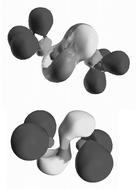A topological study of homonuclear multiple bonds between the elements of group 14
Abstract
A study of the Electron Localization Function (ELF) for [REER] and [R2EER2]
(E = Si, Ge, Sn; R = H, CH3) has been undertaken. It has long been appreciated that the bonding in the heavier group 14 analogues of


 Please wait while we load your content...
Please wait while we load your content...